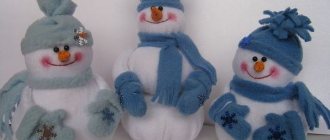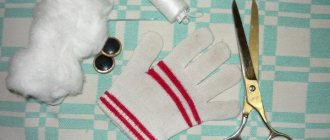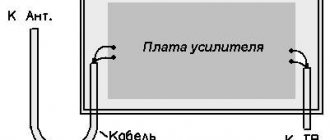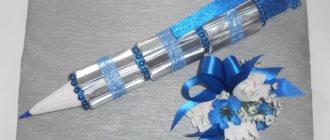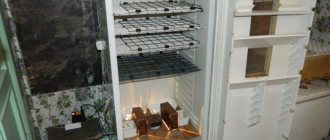Probably, many mothers of children have faced the need to sew some kind of educational toy for kindergarten. For older children, they are usually asked to sew educational books, blocks or rugs, and for very young children - toys that help children develop physically - orthopedic tracks, rugs, as well as all kinds of toys with which you can perform simple physical exercises.
One of these toys aimed at developing children’s coordination of movements is the “octopus”. Children happily jump over its tentacles, raise and lower them with their hands, while sitting on the floor.
Even a handicraft mother who is not very experienced in making toys can sew such an inhabitant of the seas. The materials needed for it are simple and affordable, and it is sewn quite simply and quickly.
From threads
The same charming octopus with pigtails can be made from thick threads. It is better to use synthetic yarn or cotton with synthetics. It holds its shape and volume perfectly. The technique for making the toy is shown in the video.
A few additional tips
- Instead of a lump of newspaper, you can use a plasticine ball or Kinder Surprise packaging.
- To prevent the threads from coming apart on the octopus’s head, you can lightly grease the filler with PVA glue.
- To accurately calculate the number of legs, you can do a simple multiplication of 15 cm (length of the octopus) x 3 (number of threads in a strand) x 3 (number of strands in a braid) x 8 (number of braids) = 1080 cm. This means we take a bundle of 9 threads 120 cm and fold it in half three times.
From a glove
This version of the sea mollusk involves both 4 legs and 8. It all depends on how many gloves you don’t mind using in your work. Moreover, the gloves do not have to be the same.
- Hide one thumb inside and carefully sew up the mark from it. Wrap the elastic band inside. Fill the remaining 4 fingers and the glove with filler and sew the top closed. To be more convincing, you can pull the glove a little at the base of the fingers. Sew button eyes and mark a mouth. The four-legged octopus is ready.
- A toy made from two gloves is a little more complicated to make with your own hands. We also remove one thumb inside and disguise its presence. We make an incision at the base of the fingers in a fingerless glove and insert another one inside it, leaving 4 fingers “outside”. We fill all 8 fingers with padding polyester, stitch them at the base, while simultaneously closing the slot. We fill the double glove with filler, first tucking the elastic. We sew up and shape the face.
Poems about octopuses
With older children 2.5 it is useful to learn poetry. Unfortunately, I couldn’t find any poems that our hero could understand. Well, maybe the first one will do. The first two lines.
***
I'm a huge octopus! I have eight legs! I can dance... And step on feet... But try to step on so many feet yourself! (T. Sofinskaya)
***
The octopus was surprised: “Why do I need eight legs?!” Answer quickly, children, Why do I need these shoots? The children answered in chorus: “There are sharks in these waters.” To escape you need eight legs at once! (V. Trusov)
***
An octopus has eight legs... Is it a little or a lot? – Eight legs are an awful lot! - This is how the lamprey would answer, Because lampreys have absolutely no legs... Eight legs are insignificant! - So the centipede would answer, Because centipedes, As you know, have many legs... And ask the octopus: - Eight - few or many? And he will answer immediately: “Eight is just right!” (In Voskoboynikov)
Very simple
Even the smallest craftsman can easily make this toy. Give your baby a handkerchief or a square piece of fabric, slightly cut on the sides (as in the photo), and a small ball made of anything: fabric, foam rubber, crumpled newspaper, a ball, and so on. Let the child throw a rag over the ball and tie a ribbon around the octopus’ “neck”. Draw the eyes or glue them together.
- two old socks, maybe different ones;
- any filler;
- wooden knitting needle;
- scissors;
- threads, needle;
- felt-tip pen.
Master class on making an octopus from socks
- Take two socks and draw lines for future cuts on them. From the toe to the middle of the foot, one of the socks will represent the head of the toy. From the heel to the elastic, we divide each sock into 4 parts lengthwise. These will be the tentacles.
- We cut out the details of the toy.
- We sew the legs, leaving them unstitched on one side, and turn them inside out.
- Using a wooden knitting needle, fill all the parts with padding polyester. Carefully sew up all the holes.
- We sew the tentacles to the head and tighten the “neck”. Let's draw a face. The toy is ready.
This version of the sea mollusk involves both 4 legs and 8. It all depends on how many gloves you don’t mind using in your work. Moreover, the gloves do not have to be the same.
- Hide one thumb inside and carefully sew up the mark from it. Wrap the elastic band inside. Fill the remaining 4 fingers and the glove with filler and sew the top closed. To be more convincing, you can pull the glove a little at the base of the fingers. Sew button eyes and mark a mouth. The four-legged octopus is ready.
- The toy made from two gloves is a little more complicated. We also remove one thumb inside and mask its presence. We make an incision at the base of the fingers in a fingerless glove and insert another one inside it, leaving 4 fingers “outside”. We fill all 8 fingers with padding polyester, stitch them at the base, while simultaneously closing the slot. We fill the double glove with filler, first tucking the elastic. We sew up and shape the face.
Doctor Otto Gunther Octavius, a supervillain, star of comics, cartoons and television series, has recently become our children's favorite toy. The doctor has his own biography, his personal and public life. It's difficult to do, but possible. We offer several options.
- A Lego villain doctor, like the one in the photo.
- Doctor Octopus from an ordinary doll with four tentacles glued to the back from scrap materials: polymer clay, boiler tubes, wire wrapped in threads, etc.
How to make a soft toy with your own hands
Every mother would like to make a wonderful soft toy for her child with her own hands, but what should those who do not have a sewing machine or special talents in needlework do, especially in conditions of acute lack of time?
And even in this case, any mother can make an excellent educational toy with her own hands! In this master class you will learn how to make a soft toy with your own hands quickly, without sewing or patterns!
A wonderful octopus in a bandana with bows on the tentacles - undoubtedly, this DIY soft toy will delight your baby! And how many benefits for the development of fine motor skills! Tentacle braids with bows will develop your baby's fingers.
The toy, of course, can be “improved.” After all, no one forbids filling the body of a toy with rustling material, and not braiding some of the tentacles, but putting various beads or rings on them? In general, there is a lot of room for imagination, and the labor costs are small.
So, do-it-yourself educational octopus toy:
Simple do-it-yourself soft toys do not require large expenses or the presence of any rare expensive materials. For the octopus toy we will need soft fleece, a ball for the head, pieces of felt for the eyes, thread and grosgrain ribbons. Well, of course, you can’t do without scissors, needles, and a piece of fabric for a scarf (if you want) will also come in handy.
For the base of the toy, take a foam ball; if desired, you can wrap it in rustling material. You can also take a plastic detachable ball and fill it with dry material such as plastic granules or beads, then the toy will also rattle.
Cut out a square of suitable size from fleece: simply wrap a piece of fabric around the ball and see how much you need to add until the length of the tentacles suits you.
Cut each side of the square with a “fringe” - 6 strips per side.
Wrap the ball in fleece again and tie it tightly at the bottom with thread.
Braid the tentacles and decorate them with grosgrain ribbon bows.
You can string beads, buttons, and various rings onto the tentacles. The main thing, if you are making a toy for a small child, is to secure these items very carefully! Tie tight knots and double stitch them with thread so that your baby cannot remove and swallow these small beads!
Very little left! Embroider the mouth and sew on circles of white and black felt - eyes. If desired, put a scarf on the octopus's head - take a triangle of fabric, trim the edges and put on the scarf.
Source
Cutting and sewing
Using the pattern of the cap wedge, you should cut out 6 parts of the octopus’s body from knitwear. Seam allowances should be as follows:
- along the side sections – 5-7 mm;
- along the bottom cut - 1 cm.
All 6 parts must be duplicated on the wrong side with an adhesive lining on a knitted base.
Then any 2 parts of the body must be sewn together along the side sections with a seam 5-7 mm wide (depending on the processing allowance). The parts should face each other, and the seam itself should be laid along the wrong side of the parts.
For ease of stitching, the parts can be pinned or basted with hand stitches.
After this, the seam allowances must be laid out in opposite directions and set aside at a distance of 1 mm from the seam.
The third part should be sewn and delayed in the same way.
The two halves of the body must be sewn together, as shown in the photo.
Then you need to cut out 12 tentacle parts (2 for each) from knitwear. Their length and width can be arbitrary. The approximate length can vary from 50 to 60 cm, the width at the widest point is 6 cm, at the narrowest point - 3-4 cm, you also need to add a processing allowance - 7 mm..
6 parts of the tentacles should be duplicated with an adhesive pad.

